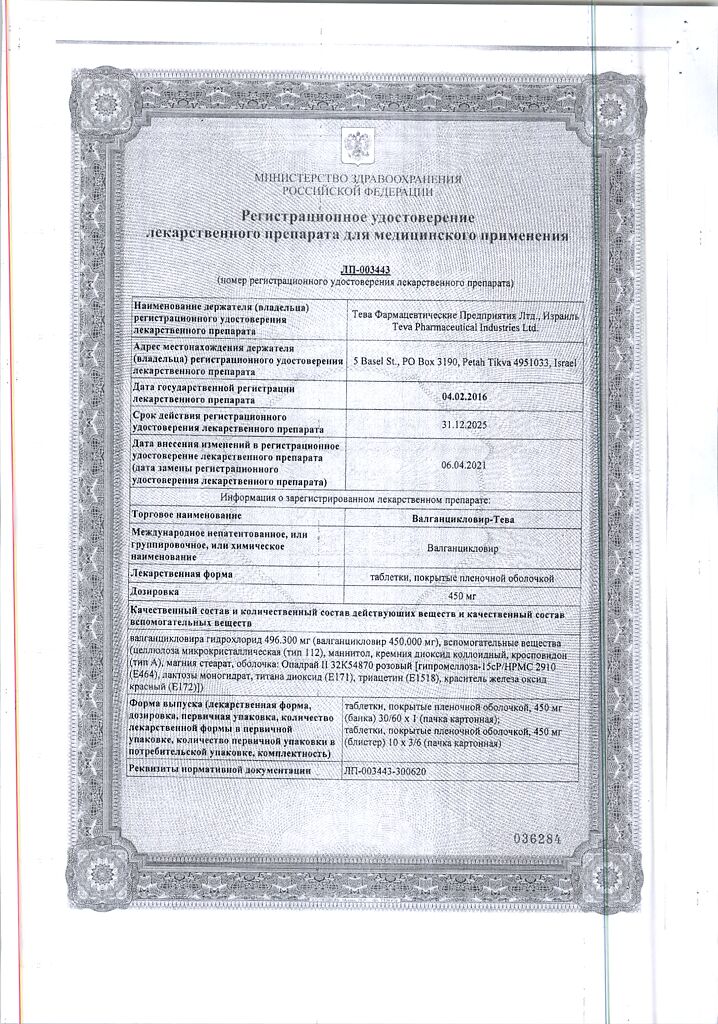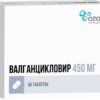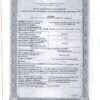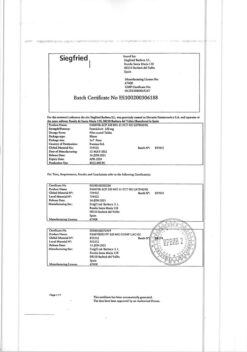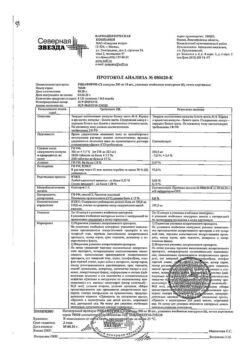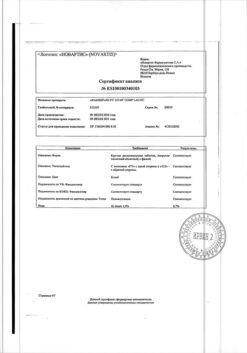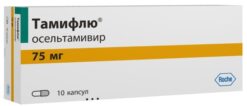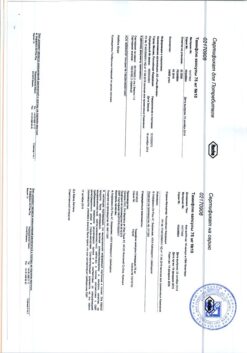No products in the cart.
Valganciclovir, 450 mg 60 pcs
€573.02 €521.10
Description
Pharmacological group: antiviral agent
ATX code: J05AB14
Pharmacological properties
Pharmacodynamics
Mechanism of action. Antiviral drug. Valganciclovir is the L-valyl ester (prodrug) of ganciclovir, which is rapidly converted to ganciclovir by intestinal and hepatic esterases after oral administration. Ganciclovir is a synthetic analog of 2′-deoxyguanosine, which inhibits the reproduction of herpes viruses in vitro and invivo. Human viruses susceptible to ganciclovir include cytomegalovirus (CMV), Herpes simplex types 1 and 2, human herpes virus types 6, 7 and 8 (HHV-6, HHV-7, HHV-8), Epstein-Barr virus, Varicella zoster virus and hepatitis B virus.
In CMV-infected cells, under the action of the viral protein kinase UL97, ganciclovir is first phosphorylated to form ganciclovirmonophosphate. Herpes simplex, with an intracellular half-life of 18 h and 6-24 h after disappearance of ganciclovir from extracellular fluid, respectively. Since phosphorylation of ganciclovir is highly dependent on the action of viral kinase, it occurs predominantly in infected cells.
Virostatic activity of ganciclovir is due to suppression of viral deoxyribonucleic acid (DNA) synthesis by:
- competitive inhibition of deoxyguanosine triphosphate incorporation into DNA by viral DNA polymerase;
- inclusion of ganciclovir triphosphate in viral DNA, leading to cessation of elongation or very limited elongation of viral DNA. A typical inhibitory concentration that suppresses CMV replication by 50% (IC50), determined by inin vitro, ranges from 0.08 µmol/L (0.02 µg/mL) to 0.14 µmol/L (3.5 µg/mL).
The clinical antiviral effect of valganciclovir has been shown to reduce CMV excretion in patients with acquired immunodeficiency syndrome (AIDS) and newly diagnosed CMV retinitis from an initial rate of 46% to 7% after 4 weeks of treatment with valganciclovir.
Effectiveness
Treatment of CMV retinitis. The use of valganciclovir in induction therapy in patients with CMV retinitis has similar clinical efficacy compared with intravenous (IV) administration of the recommended doses of ganciclovir effective in treating CMV retinitis. The area under the concentration-time curve (AUC) of ganciclovir has been shown to correlate with the length of time before progression of CMV retinitis.
Prevention of CMV infection.The incidence of CMV disease (CMV syndrome + invasive tissue infection) during the first 6 months after heart, liver, and kidney transplantation in patients at high risk for CMV infection (CMV-positive donor (D+)/CMV-negative recipient (R-) (D+/R-)) was 12.1% in patients who received valganciclovir at a dose of 900 mg/day and 15.2% in patients receiving oral ganciclovir at a dose of 1 g 3 times daily from day 10 to day 100 after transplantation. Most of the cases occurred in the period after withdrawal of prophylactic therapy (after the 100th day of the post-transplant period). The incidence of CMV infection in the valganciclovir treatment group appeared later than in the ganciclovir treatment group. The incidence of acute rejection in the first 6 months was 29.7% in patients treated with valganciclovir and 36% in patients treated with ganciclovir. The 12-month graft survival rate was 98.2% in patients receiving valganciclovir until day 100 and 98.1% in patients receiving valganciclovir until day 200. The incidence of acute graft rejection confirmed by biopsy at the first 12 months was 17.2% in patients who received valganciclovir up to day 100 and 11% in patients who received valganciclovir up to day 200.
Viral resistance. A virus resistant to ganciclovir may emerge with long-term administration of valganciclovir, which may be due to selective mutations in either the viral kinase gene (UL97) responsible for monophosphorylation of ganciclovir or in the viral DNA polymerase gene (UL54). A virus with only a mutation in the UL97 gene is only resistant to ganciclovir, while a virus with mutations in the UL54 gene can have cross-resistance to other antiviral drugs with a similar mechanism of action, and vice versa.
Treatment of CMV retinitis. Genotyping of CMV in polymorphonuclear leukocytes showed that after 3, 6, 12 and 18 months of valganciclovir treatment, UL97 mutations were detected in 2.2%, 6.5%, 12.8% and 15.3% of leukocytes, respectively.
Preventing CMV infection in patients after solid organ transplantation
Genotyping of CMV in polymorphonuclear leukocytes showed:
- absence of ganciclovir resistance-causing mutations in samples obtained at day 100 (end of prophylactic valganciclovir administration) in patients taking valganciclovir and presence of mutations in samples obtained from patients taking oral ganciclovir.
- absence of resistance mutations in samples obtained from patients taking valganciclovir with suspected CMV infection 6 months after transplantation, and presence of mutations in patients taking oral ganciclovir.
Doclinical data nosafety
Valganciclovir and ganciclovir had mutagenic effects in murine lymphoma cells and clastogenic effects in mammalian cells. These results are consistent with the positive results of a carcinogenicity study of ganciclovir in mice. Like ganciclovir, valganciclovir is a potential carcinogen.
Reproductive toxicity studies with valganciclovir have not been repeated because of the rapid and complete conversion of the drug to ganciclovir. The same warning about possible reproductive toxicity applies to both drugs. In animals, ganciclovir impairs fertility and has a teratogenic effect. Given animal experiments in which systemic exposure to ganciclovir in concentrations below therapeutic levels caused aspermia, it is likely that both ganciclovir and valganciclovir can inhibit spermatogenesis in humans.
Data from a model using the human placenta ex vivo show that ganciclovir passes through the placental barrier, most likely by simple transfer. In the concentration range of 1 to 10 mg/ml, the drug’s passage through the placenta was unsaturated and was by passive diffusion.
Pharmacokinetics
.The pharmacokinetic characteristics of valganciclovir have been studied in HIV- and CMV-seropositive patients, in patients with AIDS and CMV retinitis, and after solid organ transplantation.
Bioavailability and renal function determine ganciclovir exposure after valganciclovir administration. Bioavailability of ganciclovir was similar in all patients receiving valganciclovir. Systemic exposure of ganciclovir for heart, kidney, and liver transplant recipients was similar to that after oral valganciclovir administration according to the dosing regimen depending on renal function.
Eabsorption. Valganciclovir is a prodrug of ganciclovir that is well absorbed from the gastrointestinal tract and is rapidly converted to ganciclovir in the intestinal wall and liver. Absolute bioavailability of ganciclovir after taking valganciclovir is about 60%. Systemic exposure of valganciclovir is low and of short duration. AUC24 and maximum plasma concentration (Cmax) are approximately 1% and 3% of those of ganciclovir, respectively.
A proportional dose dependence of the AUC of ganciclovir after doses of valganciclovir between 450 and 2625 mg has been shown only for the case of valganciclovir taken after meals. If valganciclovir is administered with meals at the recommended dose of 900 mg, both the mean AUC24 (approximately 30%) and mean Cmax (approximately 14%) of ganciclovir are increased. Consequently, valganciclovir is recommended to be taken with meals.
Distribution. Metabolism. Valganciclovir is rapidly hydrolyzed to form ganciclovir; no other metabolites have been found. After a single oral ingestion of 1000 mg of radioactively labeled ganciclovir, the radioactivity of none of the metabolites in the feces or urine was greater than 1-2%. Elimation. The main route of excretion of valganciclovir, like that of ganciclovir, is glomerular filtration and active tubular secretion. Renal clearance accounts for 81.5±22% of the systemic clearance of ganciclovir. Pharmacokinetics in special clinical cases Patients with renal insufficiency. Deterioration of renal function resulted in decreased clearance of valganciclovir, with a corresponding increase in T1/2 during the terminal phase. Consequently, patients with impaired renal function require dose adjustment. Patients with hepatic impairment.The pharmacokinetics of valganciclovir were studied in patients with a stably functioning liver transplant. Absolute bioavailability of ganciclovir formed from valganciclovir (at a single oral dose of 900 mg after meal) was about 60%, which is the same as in other patients. The AUC0-24 of ganciclovir was comparable to that after an IV dose of 5 mg/kg of ganciclovir in patients who underwent liver transplantation.
Indications
Indications
Treatment of CMV retinitis in patients with AIDS;
Prevention of CMV infection in patients after solid organ transplantation in adults and children over 16 years of age at risk.
Pharmacological effect
Pharmacological effect
Pharmacological group: antiviral agent
ATC code: J05AB14
Pharmacological properties
Pharmacodynamics
Mechanism of action. Antiviral drug. Valganciclovir is the L-valyl ester (prodrug) of ganciclovir, which, after oral administration, is rapidly converted to ganciclovir by intestinal and hepatic esterases. Ganciclovir is a synthetic analogue of 2′-deoxyguanosine, which suppresses the reproduction of herpes viruses in vitro and in vivo. Human viruses sensitive to ganciclovir include cytomegalovirus (CMV), Herpes simplex types 1 and 2, human herpes virus types 6, 7 and 8 (HHV-6, HHV-7, HHV-8), Epstein-Barr virus, Varicella zoster virus and hepatitis B virus.
In CMV-infected cells, under the action of the viral protein kinase UL97, ganciclovir is first phosphorylated to form ganciclovir monophosphate. Further phosphorylation occurs by cellular kinases to form ganciclovir triphosphate, which then undergoes slow intracellular metabolism. This metabolism has been shown to occur in cells infected with CMV and Herpes simplex, and after the disappearance of ganciclovir from the extracellular fluid, the intracellular half-life of the drug is 18 hours and 6-24 hours, respectively. Since phosphorylation of ganciclovir is largely dependent on the action of the viral kinase, it occurs predominantly in infected cells.
The virostatic activity of ganciclovir is due to the suppression of the synthesis of viral deoxyribonucleic acid (DNA) by:
competitive inhibition of the incorporation of deoxyguanosine triphosphate into DNA under the action of viral DNA polymerase;
incorporation of ganciclovir triphosphate into viral DNA, resulting in cessation of elongation or very limited elongation of viral DNA. The typical inhibitory concentration that inhibits CMV replication by 50% (IC50), determined in vitro, ranges from 0.08 μmol/L (0.02 μg/ml) to 0.14 μmol/L (3.5 μg/ml).
The clinical antiviral effect of valganciclovir was proven by a decrease in the release of CMV from the body of patients with acquired immunodeficiency syndrome (AIDS) and newly diagnosed CMV retinitis from an initial rate of 46% to 7% after 4 weeks of treatment with valganciclovir.
Efficiency
Treatment of CMV retinitis. The use of valganciclovir in induction therapy in patients with CMV retinitis has similar clinical efficacy compared with intravenous (IV) ganciclovir doses effective for the treatment of CMV retinitis. The area under the concentration-time curve (AUC) of ganciclovir has been shown to correlate with the length of time to progression of CMV retinitis.
Prevention of CMV infection. The incidence of CMV disease (CMV syndrome + invasive tissue infection) during the first 6 months after heart, liver, kidney transplantation in patients with a high risk of developing CMV infection (CMV-positive donor (D+)/CMV-negative recipient (R-) (D+/R-)) was 12.1% in patients receiving valganciclovir at a dose of 900 mg/day and 15.2% in patients taking oral ganciclovir at a dose of 1 g 3 times a day from the 10th to the 100th day after transplantation. Most of the cases occurred in the period after discontinuation of preventive therapy (after the 100th day of the post-transplant period). Moreover, cases of CMV infection in the valganciclovir treatment group appeared later than in the ganciclovir treatment group. The incidence of acute rejection in the first 6 months was 29.7% in patients receiving valganciclovir and 36% in patients receiving ganciclovir. The 12-month graft survival rate was 98.2% in patients treated with valganciclovir before day 100 and 98.1% in patients treated with valganciclovir before day 200. The incidence of biopsy-proven acute graft rejection in the first 12 months was 17.2% in patients receiving valganciclovir before day 100 and 11% in patients receiving valganciclovir before day 200.
Viral resistance. With long-term use of valganciclovir, a virus resistant to ganciclovir may appear, which may be due to the selection of mutations either in the viral kinase gene (UL97), responsible for the monophosphorylation of ganciclovir, or in the viral DNA polymerase gene (UL54). A virus with only a mutation in the UL97 gene is resistant only to ganciclovir, while a virus with mutations in the UL54 gene may be cross-resistant to other antiviral drugs with a similar mechanism of action, and vice versa.
Treatment of CMV retinitis. Genotyping of CMV in polymorphonuclear leukocytes showed that after 3, 6, 12 and 18 months of treatment with valganciclovir, UL97 mutations were detected in 2.2%, 6.5%, 12.8% and 15.3% of leukocytes, respectively.
Prevention of CMV infection in patients after solid organ transplantation
Genotyping of CMV in polymorphonuclear leukocytes showed:
the absence of mutations conferring resistance to ganciclovir in samples obtained on day 100 (end of valganciclovir prophylaxis) from patients taking valganciclovir, and the presence of mutations in samples obtained from patients taking oral ganciclovir.
absence of mutations conferring resistance in samples obtained from patients taking valganciclovir with suspected CMV infection 6 months after transplantation, and the presence of mutations in patients taking oral ganciclovir.
Preclinical data no safety
Valganciclovir and ganciclovir had a mutagenic effect in murine lymphoma cells and a clastogenic effect in mammalian cells. These results are consistent with the positive results from the carcinogenicity study of ganciclovir in mice. Like ganciclovir, valganciclovir is a potential carcinogen.
Reproductive toxicity studies with valganciclovir have not been repeated due to the rapid and complete conversion of the drug to ganciclovir. Both drugs carry the same warning about possible reproductive toxicity. In animals, ganciclovir impairs fertility and has a teratogenic effect. Given animal studies in which systemic exposure to ganciclovir at subtherapeutic concentrations caused aspermia, it is likely that ganciclovir and valganciclovir may inhibit spermatogenesis in humans.
Data obtained from an ex vivo human placenta model indicate that ganciclovir crosses the placental barrier, most likely by simple transfer. In the concentration range from 1 to 10 mg/ml, the passage of the drug through the placenta was unsaturated and occurred through passive diffusion.
Pharmacokinetics
The pharmacokinetic characteristics of valganciclovir have been studied in HIV- and CMV-seropositive patients, in patients with AIDS and CMV retinitis, as well as after solid organ transplantation.
Bioavailability and renal function determine exposure to ganciclovir following administration of valganciclovir. The bioavailability of ganciclovir was similar in all patients receiving valganciclovir. Systemic exposure to ganciclovir in heart, kidney, and liver transplant recipients was similar to that after oral valganciclovir according to the dosing regimen based on renal function.
Suction. Valganciclovir is a prodrug of ganciclovir, which is well absorbed from the gastrointestinal tract and is quickly converted into ganciclovir in the intestinal wall and liver. The absolute bioavailability of ganciclovir after taking valganciclovir is about 60%. Systemic exposure of valganciclovir is low and short-term. AUC24 and maximum plasma concentration (Cmax) are approximately 1% and 3% of those of ganciclovir, respectively.
Dose proportionality of ganciclovir AUC after valganciclovir doses of 450 to 2625 mg is shown only when valganciclovir is taken after meals. When valganciclovir is administered with food at the recommended dose of 900 mg, both the mean AUC24 (approximately 30%) and mean Cmax (approximately 14%) of ganciclovir increase. Therefore, valganciclovir is recommended to be taken with food.
Distribution. Due to the rapid metabolism of valganciclovir to ganciclovir, protein binding of valganciclovir was not determined. The binding of ganciclovir to plasma proteins at concentrations from 0.5 to 51 mcg/ml is 1-2%. The equilibrium volume of distribution of ganciclovir after intravenous administration was 0.680±0.161 l/kg.
Metabolism. Valganciclovir is rapidly hydrolyzed to form ganciclovir; no other metabolites were found. After a single oral dose of 1000 mg of radiolabeled ganciclovir, the radioactivity of any of the metabolites in feces or urine was no more than 1-2%.
Withdrawal. The main route of elimination of valganciclovir, like ganciclovir, is glomerular filtration and active tubular secretion. Renal clearance accounts for 81.5±22% of systemic clearance of ganciclovir.
Pharmacokinetics in special clinical situations
Patients with renal failure. Deterioration of renal function led to a decrease in the clearance of ganciclovir formed from valganciclovir, with a corresponding increase in T1/2 in the terminal phase. Therefore, patients with impaired renal function require dose adjustment.
Patients with liver failure. The pharmacokinetics of valganciclovir were studied in patients with a stable liver transplant. The absolute bioavailability of ganciclovir derived from valganciclovir (a single 900 mg oral dose after food) was approximately 60%, which is consistent with other patients. The AUC0-24 of ganciclovir was comparable to that after intravenous administration of ganciclovir at a dose of 5 mg/kg in patients undergoing liver transplantation.
Special instructions
Special instructions
Experimental studies on animals revealed the mutagenic, teratogenic, spermicidal and carcinogenic effects of ganciclovir. The drug Valganciclovir-Teva should be considered a potential teratogen and carcinogen for humans, the use of which can cause congenital malformations and cancer. In addition, it is likely that Valganciclovir-Teva may temporarily or permanently suppress spermatogenesis.
Cases of severe leukopenia, neutropenia, anemia, thrombocytopenia, pancytopenia, bone marrow suppression and aplastic anemia have been reported in patients receiving Valganciclovir-Teva (and ganciclovir). Treatment should not be started if the ANC is less than 500/μl, or the platelet count is less than 25,000/μl, or if the hemoglobin concentration is below 80 g/l.
During treatment, it is recommended to regularly monitor the complete blood count and platelets. In patients with severe leukopenia, neutropenia, anemia and/or thrombocytopenia, it is recommended to use hematopoietic growth factors and/or interrupt the drug.
Long-term induction therapy with Valganciclovir-Teva increases the risk of myelotoxicity.
When ganciclovir is used concomitantly with imipenem/cilastatin, patients may develop seizures. The simultaneous use of valganciclovir and imipenem/cilastatin should be avoided unless the expected benefit outweighs the possible risk.
Because both zidovudine and ganciclovir can cause neutropenia and anemia, some patients may experience intolerance to concomitant use of valganciclovir and zidovudine at full doses.
Due to the possible increase in plasma concentrations of didanosine in the presence of ganciclovir, patients should be closely monitored for symptoms of didanosine toxicity.
The use of Valganciclovir-Teva simultaneously with other drugs that have a myelosuppressive or nephrotoxic effect may enhance their toxic effect.
It is not recommended to use Valganciclovir-Teva in children. The pharmacokinetic characteristics, safety and efficacy of the drug in this population have not been established.
The bioavailability of ganciclovir from the drug Valganciclovir-Teva is 10 times higher than that from ganciclovir capsules. Ganciclovir cannot be replaced with Valganciclovir-Teva in a 1:1 ratio. Patients being switched from ganciclovir capsules should be advised of the risk of overdose if they take more Valganciclovir-Teva tablets than recommended.
Patients with renal failure require dose adjustment taking into account the CC value.
Rules for handling the drug
The tablets must not be broken or crushed. Because Valganciclovir-Teva is potentially teratogenic and carcinogenic to humans, caution should be exercised if the tablet is broken. Direct contact of broken or crushed tablets with skin and mucous membranes should be avoided. In cases of such contact, it is necessary to thoroughly wash the area with soap and water; in case of contact with eyes, rinse them thoroughly with water.
The release of medicinal products into the environment should be minimized. The drug should not be disposed of with wastewater or household waste. Where possible, special systems should be used to dispose of medications.
Impact on the ability to drive vehicles. Wed and fur.:
When treated with Valganciclovir-Teva and/or ganciclovir, convulsions, sedation, dizziness, ataxia and/or confusion may occur, which may adversely affect activities requiring increased concentration, including driving and operating machinery. In this regard, during treatment with Valganciclovir-Teva, care should be taken when driving vehicles and working with machines and mechanisms. If the described adverse events occur, you should refrain from performing these activities.
Active ingredient
Active ingredient
Valganciclovir
Composition
Composition
1 tablet contains: active ingredient valganciclovir hydrochloride 496.300 mg (valganciclovir 450.000 mg); excipients: microcrystalline cellulose (type 112) 70,000 mg; mannitol 86.230 mg; colloidal silicon dioxide 3,400 mg; crospovidone (type A) 10.050 mg; magnesium stearate 4.020 mg; shell Opadry II 32K54870 pink 26.800 mg: hypromellose-15cP / HPMC 2910 (E464) 10.720 mg; lactose monohydrate 6,700 mg; titanium dioxide (E171) 6.218 mg; triacetin (E1518) 2.948 mg; iron oxide red dye (E172) 0.214 mg.
Pregnancy
Pregnancy
Reproductive toxicity studies with valganciclovir have not been repeated due to the rapid and complete conversion of valganciclovir to ganciclovir. Ganciclovir impairs fertility and is teratogenic in animals.
During treatment with Valganciclovir-Teva, women of reproductive age should be advised to use effective methods of contraception. Men are recommended to use a barrier method of contraception during treatment with Valganciclovir-Teva and for at least 90 days after its completion.
The safety of valganciclovir during human pregnancy has not been established. During pregnancy, the use of Valganciclovir-Teva should be avoided, except in cases where the expected benefit to the mother outweighs the possible risk to the fetus.
Peri- and postnatal development with the use of valganciclovir and ganciclovir has not been studied, but the possibility of excretion of ganciclovir in breast milk and the development of serious adverse reactions in the nursing infant cannot be excluded. Thus, the decision to discontinue Valganciclovir-Teva or stop breastfeeding should be made based on an assessment of the potential effect of treatment for the nursing mother and the risk to the infant.
Contraindications
Contraindications
Hypersensitivity to valganciclovir, ganciclovir or other components of the drug. Due to the similar chemical structure of acyclovir, valacyclovir and valganciclovir, cross-sensitivity reactions are possible;
Absolute neutrophil count (ANC) less than 500/μl; platelet count less than 25,000/µl; hemoglobin concentration less than 80 g/l;
CC less than 10 ml/min;
Children under 16 years of age (prevention of CMV infection after solid organ transplantation in adults and children over 16 years of age at risk);
– children under 18 years of age (treatment of CMV retinitis in adults with AIDS).
With caution:
Elderly patients (safety and effectiveness have not been established).
Side Effects
Side Effects
Valganciclovir is a prodrug of ganciclovir. Valganciclovir, after oral administration, is rapidly converted to ganciclovir, therefore all known adverse events (AEs) reported with ganciclovir are expected with valganciclovir.
In the treatment of CMV retinitis in patients with AIDS
The safety profiles of valganciclovir and ganciclovir when administered intravenously for 28 days were similar. The most common AEs were diarrhea, neutropenia, and fever. In patients taking valganciclovir orally, candidiasis of the oral mucosa was more often observed. headache and weakness; when using IV ganciclovir, patients more often experienced nausea and AEs at the injection site (phlebitis and thrombophlebitis) (see Table No. 1).
Table No. 1. Proportion of patients (%) with individual AEs during therapy for CMV retinitis
Adverse event
Treatment with oral valganciclovir (N=79)
Treatment with IV ganciclovir (N=79)
Diarrhea
16%
10%
Candidiasis of the oral mucosa
11%
6%
Headache
9%
5%
Weakness
8%
4%
Nausea
8%
14%
Phlebitis and thrombophlebitis
–
6%
Table No. 2 presents the most common AEs (regardless of their severity and connection with taking valganciclovir) with an incidence of at least 5%, obtained during treatment with valganciclovir or in patients with CMV retinitis. or in patients after solid organ transplantation.
The most common AEs, regardless of severity, associated with valganciclovir (remote, probable or possible association) in patients with CMV retinitis were neutropenia (21%), diarrhea (14%), nausea (9%), anemia (14%).
For the prevention of CMV retinitis in patients after organ transplantation
Table 2 summarizes adverse events (up to 28 days after study completion), regardless of severity or drug-related, with an incidence of ≥5% observed in clinical trials in solid organ transplant patients receiving oral valganciclovir or ganciclovir starting within 10 days of transplantation and continuing until day 100 of the posttransplant period.
The most common adverse reactions, regardless of severity, but, according to investigators, associated with taking the drug (remote, probable or possible connection) in patients after solid organ transplantation who received treatment before the 100th day of the post-transplant period: leukopenia, diarrhea, nausea, neutropenia; in patients who underwent kidney transplantation and received treatment before the 200th day of the post-transplant period: leukopenia, neutropenia, anemia and diarrhea.
Table No. 2. Proportion of patients (%) with AEs occurring in at least 5% of patients with CMV retinitis or after organ transplantation during therapy with valganciclovir and ganciclovir
Adverse event
Proportion of patients (%) with CMV retinitis
Proportion of patients (%) after solid organ transplantation who received treatment on the 100th day of the post-transplant period
Valganciclovir (N=370)
Valganciclovir (N=244)
Ganciclovir (oral) (N=126)
From the digestive system
Diarrhea
38
30
29
Nausea
25
23
23
Vomit
20
16
14
Abdominal pain
13
14
14
Constipation
6
20
20
Pain in the upper abdomen
6
9
6
Dyspepsia
4
12
10
Bloating
2
6
6
Ascites
–
9
6
Liver dysfunction
3
9
11
From the body as a whole
Fever
26
13
14
Fatigue
20
13
15
Edema of the lower extremities
5
21
16
Pain
3
5
7
Edema
1
11
9
Peripheral edema
1
6
7
Weakness
4
6
6
From the blood and lymphatic system
Neutropenia
24
8
3
Anemia
22
12
15
Thrombocytopenia
5
5
5
Leukopenia
4
14
7
Infectious complications
Candidiasis of the oral mucosa
20
3
3
Pharyngitis/nasopharyngitis
12
4
8
Sinusitis
10
3
–
Upper respiratory tract infections
9
7
7
Flu
9
–
–
Pneumonia
7
4
2
Bronchitis
6
–
1
Pneumocystis pneumonia
6
–
–
Urinary tract infections
5
11
9
From the nervous system
Headache
18
22
27
Insomnia
14
20
16
Peripheral neuropathy
7
1
1
Paresthesia
6
5
5
Tremor
2
28
25
Dizziness (except vertigo)
9
10
6
Depression
9
7
6
From the skin and subcutaneous tissues
Dermatitis
18
4
5
Night sweats
7
3
4
Itching
6
7
4
Acne
Less than 1
4
6
Rash
9
Less than 1
–
From the respiratory system
Cough
16
6
8
Dyspnea
9
11
10
Productive cough
5
2
2
Nasal discharge
2
4
6
Pleural effusion
Less than 1
7
8
From the senses
Retinal detachment
13
–
–
Blurred vision
6
1
4
From the musculoskeletal system
Back pain
8
20
15
Arthralgia
6
7
7
Muscle cramps
2
6
11
Pain in limbs
3
5
7
From the urinary system
Kidney failure
1
7
12
Dysuria
2
7
6
From the immune system
Transplant rejection reaction
–
24
30
Metabolism
Anorexia
5
3
–
Cachexia
5
–
–
Decreased appetite
8
4
5
Dehydration
6
5
6
Weight loss
9
3
3
From the cardiovascular system
Decreased blood pressure
1
3
8
Increased blood pressure
3
18
15
Laboratory indicators
Hyperkalemia
Less than 1
14
14
Hypokalemia
2
8
8
Hypomagnesemia
Less than 1
8
8
Hyperglycemia
1
6
7
Hypophosphatemia
Less than 1
9
6
Hypocalcemia
Less than 1
4
6
Hypercreatininemia
1
10
14
Postoperative complications
Postoperative complications
1
12
8
Pain in the postoperative period
2
13
7
Infection of a postoperative wound
1
11
6
Increased frequency of need for drainage
5
9
Poor wound healing
Less than 1
5
6
The following lists serious adverse events associated with valganciclovir that occur with an incidence of less than 5% and are not listed above.
From the blood and lymphatic system: pancytopenia, bone marrow suppression, aplastic anemia, febrile neutropenia, potentially life-threatening bleeding associated with the development of thrombocytopenia.
From the urinary system: decreased creatinine clearance.
From the nervous system: convulsions, psychotic deviations, hallucinations, confusion, agitation.
Other: hypersensitivity reactions to valganciclovir.
Severe neutropenia (absolute neutrophil count less than 500 per microliter) is more common in patients with CMV retinitis (16%) than in patients receiving valganciclovir (5%) or oral ganciclovir (3%) after organ transplantation before post-transplant day 100 or in patients receiving valganciclovir (10%) before post-transplant day 200 period.
Patients receiving both valganciclovir and ganciclovir orally after organ transplantation before post-transplant day 100 or day 200 experienced greater increases in serum creatinine concentrations compared with patients with CMV retinitis. Renal dysfunction is common in patients who have undergone organ transplantation.
The overall safety profile of valganciclovir does not change when the period of prophylactic use is extended to 200 days in at-risk kidney transplant patients. In patients receiving valganciclovir before day 200 of the posttransplant period, compared with patients receiving valganciclovir before day 100 of the posttransplant period, there was a slight increase in the incidence of leukopenia.
The incidence of neutropenia, anemia and thrombocytopenia is similar in patients receiving treatment before the 100th day and 200th day of the post-transplant period.
Table No. 3. Laboratory indicators when using valganciclovir
Laboratory indicators
Proportion of patients (%) with CMV retinitis
Proportion of patients (%) after solid organ transplantation who received treatment on the 100th day of the post-transplant period
Valganciclovir (N=370)
Valganciclovir (N=244)
Ganciclovir (oral) (N=126)
Neutropenia (ANN (cells/µl))
Less than 500
16
5
3
500 – less than 750
17
3
2
750 – less than 1000
17
5
2
Anemia (hemoglobin (g/l))
Less than 65
7
1
2
65 – less than 80
10
5
7
80 – less than 95
14
31
25
Thrombocytopenia (platelet count (cells/μl))
Less than 25000
3
0
2
25000 – less than 50000
5
1
3
50000 – less than 100000
21
18
21
Serum creatinine concentration (mg/dL)
More than 2.5
2
14
21
More than 1.5-2.5
11
45
47
Experience with ganciclovir
Because valganciclovir is rapidly converted to ganciclovir, the following are AEs described during treatment with ganciclovir and not mentioned above.
From the digestive system: dryness of the oral mucosa, cholangitis, dysphagia, belching, esophagitis, fecal incontinence, flatulence, gastritis, gastrointestinal disorders, gastrointestinal bleeding, ulcerative stomatitis, pancreatitis, glossitis, hepatitis, jaundice.
From the body as a whole: asthenia, bacterial, fungal and viral infections, malaise, mucositis, tremors, sepsis.
From the skin and subcutaneous tissues: alopecia, photosensitivity reactions, dry skin, sweating, urticaria.
From the nervous system: sleep disturbance, amnesia, anxiety, ataxia, coma, emotional disorders, hyperkinesis, hypertonicity, decreased libido, myoclonic twitching, nervousness, drowsiness, intellectual impairment.
From the musculoskeletal system: pain in bones and muscles, myasthenic syndrome.
From the genitourinary system: hematuria, impotence, frequent urination.
Laboratory indicators: increased activity of alkaline phosphatase, creatinine phosphokinase, lactate dehydrogenase in the blood plasma, decreased concentration of glucose in the blood, hypoproteinemia.
From the senses: amblyopia, blindness, ear pain, hemorrhages in the eye, pain in the eyeballs, deafness, glaucoma, taste disturbances, tinnitus, blurred vision, non-systemic dizziness, changes in the vitreous body.
From the hematopoietic system: eosinophilia, leukocytosis, lymphadenopathy, splenomegaly, bleeding.
From the cardiovascular system: arrhythmias (including ventricular), deep vein thrombophlebitis, migraine, phlebitis, tachycardia, vasodilation.
From the respiratory system: congestion in the paranasal sinuses.
From the endocrine system: diabetes mellitus.
Children
Prevention of CMV infection in patients after organ transplantation
Table 4 presents adverse events (that developed up to 28 days after completion of the study), regardless of their severity and in connection with taking the drug.
The table includes adverse events with an incidence of ≥10% reported in clinical trials in children aged 3 weeks to 16 years after solid organ transplantation who started valganciclovir within 10 days after transplantation and continued treatment until the 100th day of the post-transplant period, as well as in children after kidney transplantation who started valganciclovir within 10 days after transplantation and continued treatment until 200th day of the post-transplant period.
The overall safety profile of valganciclovir in children does not differ from the safety profile of the drug in adults. Some adverse events were observed at a higher frequency in children than in adults, such as upper respiratory tract infections, fever, abdominal pain and dysuria, which may reflect characteristics of the pediatric population. In the pediatric population, there was a slight increase in the incidence of neutropenia, but this did not lead to an increase in the incidence of infections.
In children who have undergone kidney transplantation, increasing the period of prophylactic use to 200 days does not lead to an increase in the incidence of adverse events.
Table 4. Adverse events occurring with an incidence of ≥ 10% in children after solid organ transplantation.
Body systems/description of AEs
Pediatric patients (%) after solid organ transplantation
Treatment with valganciclovir until the 100th day of the post-transplant period (N=63)
Treatment with valganciclovir until day 200 of the post-transplant period (N=56)
Infectious complications
Urinary tract infections
6
34
Urinary tract infections caused by E. coli
–
13
Upper respiratory tract infections
22
34
From the digestive system
Diarrhea
32
32
Constipation
11
5
Nausea
11
9
Stomach ache
6
18
Vomit
21
13
From the blood and lymphatic system
Leukopenia
2
25
Anemia
14
16
Neutropenia
13
23
From the body as a whole
Fever
24
16
Laboratory indicators
Hypercreatinemia
2
16
From the urinary system
Hematuria
6
11
Dysuria
2
18
From the nervous system
Tremor
3
18
Headache
6
21
From the cardiovascular system
Increased blood pressure
22
16
From the immune system
Transplant rejection reaction
10
5
Severe neutropenia was more common in pediatric kidney transplant recipients who received valganciclovir before post-transplant day 200 compared with children receiving valganciclovir before post-transplant day 100, and compared with adults who received kidney transplants who received valganciclovir before post-transplant day 100 and 200. post-transplantation period.
Congenital CMV infection
Limited available data suggest that the safety profile of valganciclovir or ganciclovir administered for up to 6 months for the treatment of congenital CMV infection in neonates aged 2 to 31 days is no different from that in adults. Grades 3 and 4 neutropenia were most frequently reported with ganciclovir use (38%). In only one case, antiviral therapy was discontinued due to the development of neutropenia. in other cases, neutropenia was correctable without discontinuation of therapy. All newborns showed an increase in indicators characterizing growth and development (height, body weight, average head circumference). The most common adverse events with valganciclovir were neutropenia. anemia, impaired liver function and diarrhea (it should be noted that these adverse events occurred in patients who did not receive the drug, and with a higher frequency than in patients who received the drug). The only serious treatment-related adverse events were neutropenia and anemia (also more common in patients not receiving the drug). There were no statistically or clinically significant differences between patients receiving and not receiving valganciclovir in indicators characterizing growth and development (height, body weight, average head circumference).
Table 5. Changes in laboratory parameters when using valganciclovir in children
Changes in laboratory parameters
Pediatric patients (%) after solid organ transplantation
Treatment with valganciclovir on the 100th day of the post-transplant period (N=63)
Treatment with valganciclovir on the 100th day of the post-transplant period (N=56)
Neutropenia (ANN (cells/µl))
Less than 500
5
30
500 – less than 750
8
7
750 – less than 1000
5
11
Anemia (hemoglobin (g/l))
Less than 65
0
0
65 – less than 80
14
5
80 – less than 95
38
29
Thrombocytopenia (platelet count (cells/μl))
Less than 25000
0
0
25000 – less than 50000
10
0
50000 – less than 100000
3
4
Serum creatinine concentration (mg/dL)
More than 2.5
2
5
More than 1.5-2.5
11
20
Experience of post-marketing use of the drug
The following are AEs described in spontaneous reports during post-marketing use of ganciclovir. not mentioned in any of the above sections for which a causal relationship with valganciclovir cannot be excluded. Since valganciclovir is quickly and largely converted to ganciclovir, these adverse reactions may also occur during treatment with valganciclovir: anaphylaxis, decreased fertility in men.
AEs reported with post-marketing use of valganciclovir are similar to those observed in clinical studies of valganciclovir and ganciclovir.
Interaction
Interaction
In an in situ model of intestinal permeability in rats, no interactions were observed between valganciclovir and valacyclovir, didanosine, nelfinavir, cyclosporine, omeprazole, and mycophenolate mofetil.
Valganciclovir is converted to ganciclovir, so interactions associated with ganciclovir can also be expected with valganciclovir.
The binding of ganciclovir to plasma proteins is only 1-2%, so reactions associated with the replacement of protein binding should not be expected.
Seizures have been reported in patients receiving ganciclovir and imipenem/cilastatin concomitantly. The simultaneous use of these drugs should be avoided unless the expected benefit outweighs the possible risk.
Concomitant oral administration of probenecid may result in an approximately 20% decrease in the renal clearance of ganciclovir and an increase in the duration of action (40%). This is explained by the mechanism of interaction – competition for tubular renal excretion. Patients taking probenecid and valganciclovir concomitantly should be monitored for ganciclovir toxicity.
When used concomitantly with oral ganciclovir, the AUC of zidovudine may slightly but statistically increase (17%); in addition, there was a trend, statistically insignificant, towards a decrease in the concentration of ganciclovir. Because both zidovudine and ganciclovir can cause neutropenia and anemia, some patients may not tolerate concomitant use of these drugs at full doses.
Plasma concentrations of didanosine were found to persistently increase with simultaneous administration of both intravenous and oral ganciclovir. When taking ganciclovir orally at a dose of 3 g and 6 g / day. The AUC of didanosine increased by 84-124%, and with intravenous administration of ganciclovir in doses of 5-10 mg/kg/day. The AUC of didanosine increased by 38-67%. This increase cannot be explained by competition for renal tubular excretion, since the percentage of didanosine excreted increased. The reason for this increase may be either an increase in bioavailability or inhibition of metabolism. There was no clinically significant effect on ganciclovir concentrations. However, given the increase in plasma concentrations of didanosine in the presence of ganciclovir, patients should be carefully monitored for symptoms of didanosine toxicity.
Based on the results of a study of a single recommended dose of IV ganciclovir and oral mycophenolate mofetil, and the known effects of renal impairment on the pharmacokinetics of ganciclovir and mycophenolate mofetil, concomitant use of these drugs, which compete for tubular secretion, would be expected to result in increased concentrations of ganciclovir and the phenolic glucuronide mycophenolic acid. No significant changes in the pharmacokinetics of mycophenolic acid are expected, and no dose adjustment of mycophenolate mofetil is required. In patients with renal impairment who are receiving valganciclovir and mycophenolate mofetil concomitantly, ganciclovir dose adjustment recommendations and close monitoring should be followed.
Zalcitabine increases the AUC0-8 of oral ganciclovir by 13%. There were no statistically significant changes in other pharmacokinetic parameters. There were also no clinically significant changes in the pharmacokinetics of zalcitabine during concomitant oral administration of ganciclovir, despite a slight increase in the elimination rate constant.
With simultaneous oral administration of stavudine and ganciclovir, no statistically significant pharmacokinetic interaction is observed.
Trimethoprim statistically significantly (by 16.3%) reduces the renal clearance of ganciclovir taken orally, which is accompanied by a statistically significant decrease in the rate of terminal elimination and a corresponding increase in Tsh by 15%. However, the clinical significance of these changes is unlikely, since AUC0-8 and Cmax do not change. The only statistically significant change in the pharmacokinetic parameters of trimethoprim while taking ganciclovir was an increase in Cmin. However, this is unlikely to be of clinical significance and no dose adjustment is required.
When comparing cyclosporine concentrations before the next dose, there was no evidence that ganciclovir altered the pharmacokinetics of cyclosporine. However, after initiation of ganciclovir, a slight increase in maximum serum creatinine concentration was observed.
The use of ganciclovir concomitantly with other drugs that have a myelosuppressive effect or impair renal function (for example, dapsone, pentamidine, flucytosine, vincristine, vinblastine, adriamycin, amphotericin B, nucleoside analogues and hydroxyurea) may increase their toxic effects. Therefore, these drugs should only be used concomitantly with ganciclovir if the potential benefit outweighs the possible risk.
Other possible drug interactions: Since the main route of elimination of ganciclovir is by glomerular filtration and active tubular secretion, the use of valganciclovir concomitantly with antiretroviral drugs that are also eliminated by active tubular secretion (for example, nucleos(t)ide reverse transcriptase inhibitors) may affect the concentrations of valganciclovir and/or co-administered drugs. The use of ganciclovir concomitantly with other drugs that have a myelosuppressive or nephrotoxic effect (for example, dapsone, pentamidine, flucytosine, vincristine, vinblastine, adriamycin, amphotericin B, nucleoside analogues, hydroxyurea and pegylated interferons/ribavirin) may increase their toxic effects. Therefore, these drugs can be used simultaneously with valganciclovir only if the expected benefit from the treatment outweighs the possible risk.
Overdose
Overdose
In one adult patient, after using the drug for several days in doses no less than 10 times higher than those recommended for him, taking into account kidney damage (decreased creatinine clearance), suppression of bone marrow function (medullary aplasia) developed with a fatal outcome.
It is possible that an overdose of valganciclovir may lead to nephrotoxicity. Plasma concentrations of valganciclovir can be reduced in patients with overdose by hemodialysis and hydration.
Overdose of ganciclovir with intravenous administration
During clinical trials and post-registration use of the drug, cases of overdose of intravenously administered ganciclovir were described. Some of them were not accompanied by AEs. Most patients experienced one or more of the following AEs:
– hematological toxicity (pancytopenia, bone marrow suppression, medullary aplasia, leukopenia, neutropenia, granulocytopenia);
– hepatotoxicity (hepatitis, liver dysfunction);
– nephrotoxicity (increased hematuria in patients with existing kidney damage, acute renal failure, increased creatinine concentration);
– gastrointestinal toxicity (abdominal pain, diarrhea, vomiting);
– neurotoxicity (generalized tremor, convulsions).
Storage conditions
Storage conditions
Store at a temperature not exceeding 25 °C.
KEEP OUT OF REACH OF CHILDREN!
Shelf life
Shelf life
3 years. Do not use after expiration date.
Manufacturer
Manufacturer
Pliva Hrvatska d.o.o., Croatia
Additional information
| Shelf life | 3 years. Do not use after the expiration date. |
|---|---|
| Conditions of storage | Store at a temperature not higher than 25 ° C. KEEP OUT OF REACH OF CHILDREN! |
| Manufacturer | Pliva Hrvatska d.o.o., Croatia |
| Medication form | pills |
| Brand | Pliva Hrvatska d.o.o. |
Related products
Buy Valganciclovir, 450 mg 60 pcs with delivery to USA, UK, Europe and over 120 other countries.


